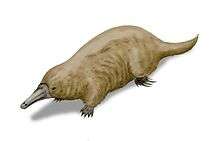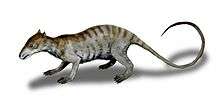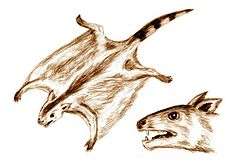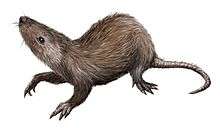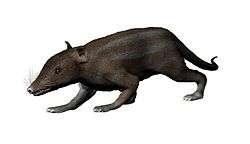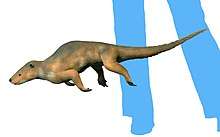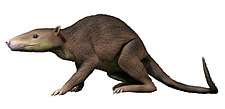Morganucodon
Morganucodon ("Glamorgan tooth") is an early mammaliaform genus that lived during the late Triassic period. It first appeared about 205 million years ago. Unlike many other early mammals, Morganucodon is well represented by abundant and well preserved (though in the vast majority of cases disarticulated) material. Most of this comes from Glamorgan in Wales (Morganucodon watsoni), but fossils have also been found in Yunnan Province in China (Morganucodon oehleri) and various parts of Europe and North America. Some closely related animals (Megazostrodon) are known from exquisite fossils from South Africa.[2]
| Morganucodon | |
|---|---|
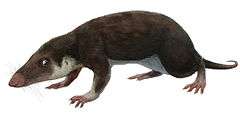 | |
| Restoration of M. watsoni | |
| Scientific classification | |
| Kingdom: | Animalia |
| Phylum: | Chordata |
| Clade: | Therapsida |
| Clade: | Cynodontia |
| Family: | †Morganucodontidae |
| Genus: | †Morganucodon Kühne, 1949 |
| Type species | |
| Morganucodon watsoni Kühne, 1949 | |
| Species | |
| |
The name comes from a Latinization of Morganuc, "South Glamorgan in the Domesday Book", the county where it was discovered by Walter Georg Kühne,[3] so it means "Glamorgan tooth". It has acquired the nickname Morgie in the Smithsonian National Museum of Natural History.[4]
Biology
Morganucodon was a small, plantigrade animal. The tail was moderately long. According to Kemp (2005), "the skull was 2–3 cm in length and a presacral body length of about 10 cm [4 inches]. In general appearance, it would have looked like a shrew or mouse".[5] There is evidence that it had specialized glands used for grooming, which may indicate that, like present day mammals, it had fur.[6]
Like present day mammals of similar size and presumed habit, Morganucodon was likely nocturnal and spent the day in a burrow. There is no direct fossil evidence, but several lines of evidence point to a nocturnal bottleneck in the evolution of the mammal class, and almost all modern mammals of similar size to Morganucodon are still nocturnal.[7][8] Likewise, burrowing was widespread both in the cynodonts and in primitive mammals.[9][10] The logics of phylogenetic bracketing would make Morganucodon nocturnal and burrowing too. Plant material from the conifer Hirmeriella was also found in the fissure fills, indicating Morganucudon lived in, or near, a forested area.
The diet appears to have been insects and other small animals, with a preference for hard prey such as beetles.[11] Like most modern mammal insectivores, it grew fairly quickly to adult size. [12] Its eggs were probably small and leathery, a condition still found in monotremes.[13]
The teeth grew in mammalian fashion, with deciduous teeth being replaced by permanent teeth that were retained throughout the rest of the animal's life.[14] The combination of rapid growth in juveniles and a toothless stage at infancy strongly suggests that Morganucodon raised its young by lactation; indeed, it may have been among the very first animals to do so.[15] The molars in the adult had a series of raised humps and edges that fit into each other, allowing for efficient chewing. However, unlike the situation in most later mammals, the upper and lower molars did not occlude properly when they first met; as they wore against each other, however, their shapes were modified by wear to produce a precise fit.[16]
The metabolism of Morganucodon was significantly slower than that of comparably sized modern mammals, and it had a life-span similar to reptiles.[17] Thus it likely did not possess the endothermic metabolism as seen in current mammals.
Classification

Morganucodon is the type genus for the order Morganucodonta, a group of generally similar mammals or pre-mammals from Late Triassic to Middle Jurassic time[18] of the close relatives. All were small and mainly insectivores. Of the small bodied relatives, Morganucodon is the best preserved and best understood find.
There is currently controversy about whether or not to classify Morganucodon as a mammal or as a non-mammalian mammaliaform. Some researchers limit the term "mammal" to the crown group mammals, which would not include Morganucodon and its relatives. Others, however, define "mammals", as a group, by the possession of a special, secondarily evolved jaw joint between the dentary and the squamosal bones, which has replaced the primitive one between the articular and quadrate bones in all modern mammalian groups. Under this definition, Morganucodon would be a mammal. Nevertheless, its lower jaw retains some of the bones found in its non-mammalian ancestors in a very reduced form rather than being composed solely of the dentary. Furthermore, the primitive reptile-like jaw joint between the articular and quadrate bones, which in modern mammals has moved into the middle ear and become part of the ear ossicles as malleus and incus, is still to be found in Morganucodon.[19] Morganucodon also suckled (it may have been the earliest animal to do so), had only two sets of teeth and grew rapidly to adult size and stopped growing thereafter, all typical mammalian traits.[20]
- Phylogeny [21]
| Mammaliaformes |
| ||||||||||||||||||||||||||||||||||||||||||||||||
See also
References
- Butler, P.M. and Sigogneau-Russell, D. 2016. Diversity of triconodonts in the Middle Jurassic of Great Britain. Palaeontologia Polonica 67, 35–65. LSID urn:lsid:zoobank.org: pub: C4D90BB6-A001-4DDB-890E-2061B4793992
- Pages 21–33, 174 in Zofia Kielan-Jaworowska, Richard L. Cifelli, and Zhe-Xi Luo, Mammals from the Age of Dinosaurs: Origins, Evolution, and Structure, Columbia University Press, New York, 2004 ISBN 0-231-11918-6
- Walter G. Kühne, "On a Triconodont tooth of a new pattern from a Fissure-filling in South Glamorgan", Proceedings of the Zoological Society of London, volume 119 (1949–1950) pages 345–350
- National Museum of Natural History: Photographs of the new Kenneth E. Behring Family Hall of Mammals
- Kemp T.S. 2005. The origin and evolution of mammals, Oxford University Press, page 143. ISBN 0-19-850760-7.
- Ruben, J.A.; Jones, T.D. (2000). "Selective Factors Associated with the Origin of Fur and Feathers" (PDF). American Zoologist. 40 (4): 585–596. doi:10.1093/icb/40.4.585.
- Hall, M. I.; Kamilar, J. M.; Kirk, E. C. (24 October 2012). "Eye shape and the nocturnal bottleneck of mammals". Proceedings of the Royal Society B: Biological Sciences. 279 (1749): 4962–4968. doi:10.1098/rspb.2012.2258. PMC 3497252. PMID 23097513.
- Muchlinski, Magdalena N. (June 2010). "A comparative analysis of vibrissa count and infraorbital foramen area in primates and other mammals". Journal of Human Evolution. 58 (6): 447–473. doi:10.1016/j.jhevol.2010.01.012. PMID 20434193.
- Damiani, R.; Modesto, S.; Yates, A.; Neveling, J. (22 August 2003). "Earliest evidence of cynodont burrowing". Proceedings of the Royal Society B: Biological Sciences. 270 (1525): 1747–1751. doi:10.1098/rspb.2003.2427. PMC 1691433. PMID 12965004.
- KIELAN, ZOFIA; GAMBARYAN, PETR P. (December 1994). "Postcranial anatomy and habits of Asian multituberculate mammals". Lethaia. 27 (4): 300. doi:10.1111/j.1502-3931.1994.tb01578.x.
- Gill, Pamela G.; Purnell, Mark A.; Crumpton, Nick; Robson-Brown, Kate; Gostling, Neil J.; Stampanoni, M.; Rayfield, Emily J. (21 August 2014). "Dietary specializations and diversity in feeding ecology of the earliest stem mammals". Nature. 512 (7514): 303–305. doi:10.1038/nature13622. hdl:2381/29192. PMID 25143112.
- Chinsamy, A.; Hurum, J.H. (2006). "Bone microstructure and growth patterns of early mammals" (PDF). Acta Palaeontologica Polonica. 51 (2): 325–338. Retrieved 30 August 2013.
- Parente, Raphael Câmara Medeiros; Bergqvist, Lílian Paglarelli; Soares, Marina Bento; Filho, Olimpio Barbosa Moraes (2011). "The history of vaginal birth". Archives of Gynecology and Obstetrics. 284 (1): 1–11. doi:10.1007/s00404-011-1918-6. PMID 21547459.
- Alexander F. H. van Nievelt and Kathleen K. Smith, "To replace or not to replace: the significance of reduced functional tooth replacement in marsupial and placental mammals", Paleobiology, Volume 31, Issue 2 (June 2005) pages 324–346
- Kielan-Jaworowska, Zofia; Cifelli, Richard L.; Luo, Zhe-Xi (2004). Mammals from the age of dinosaurs : origins, evolution, and structure. New York: Columbia University Press. pp. 148–153. ISBN 978-0231119184.
- Crompton, A. W.; Jenkins, F. Jr. (1968). "Molar occlusion in late Triassic mammals". Biological Reviews. 43 (4): 427–458. doi:10.1111/j.1469-185x.1968.tb00966.x. PMID 4886687.
- Newham, Elis; et al. (2019). "Reptile-like physiology in Early Jurassic stem-mammals". bioRxiv: 785360. doi:10.1101/785360.
- pages 511–512, Malcolm C. McKenna and Susan K. Bell, Classification of Mammals Above the Species Level, Columbia University Press, 1997. ISBN 0-231-11012-X
- Kermack, K. A.; Mussett, Frances; Rigney, H. W. (1981). "The skull of Morganucodon". Zoological Journal of the Linnean Society. 71: 1–158. doi:10.1111/j.1096-3642.1981.tb01127.x.
- Mammals of the Mesozoic: The least mammal-like mammals
- Close, Roger A.; Friedman, Matt; Lloyd, Graeme T.; Benson, Roger BJ (2015). "Evidence for a mid-Jurassic adaptive radiation in mammals". Current Biology. 25 (16): 2137–2142. doi:10.1016/j.cub.2015.06.047. PMID 26190074.

